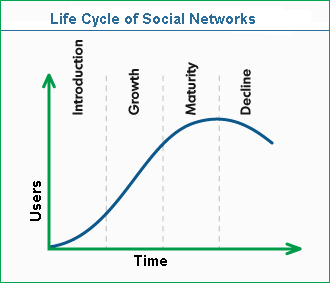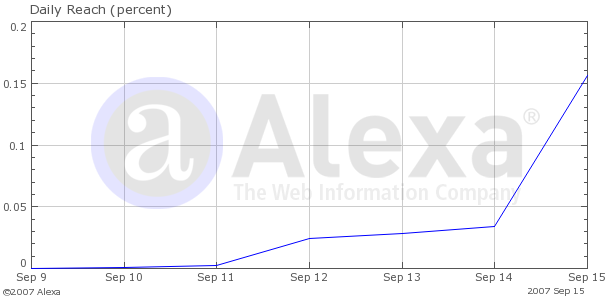This is a guest post by Babu M. Varghese.
The launch of Geocities by Yahoo marked for some the beginning of a new revolution in the online media called social networking. Later, several other websites such as Classmates.com and Friendster contributed to the development of social networking to help reach our present day scenario, where we see the domination of Facebook, Twitter, LinkedIn, and Google+. From an evolutionary standpoint and through historical data, there have been several milestones that have been reached that can help us formulate a true life cycle phenomenon in the social networking space.
Every product or service has a product life cycle, and despite the popularity of social networking in this day and age, even social network sites have a product life cycle scenario. Thinking about it in a different way, humans also have a life cycle beginning at birth and ending at death. They go through infancy, growth, maturity, and death. Likewise, social networking is also subject to several stages of its own life cycle.
For social networks, the life cycle appears to fit these stages:
Introduction
The Introduction is a stage where the service is introduced to the users and where new users begin to register for the service. Through networking, users also invite their friends and followers to use the service. Google+ is currently in its introductory phase. It’s an innovative platform in the social networking space. At this stage, most early adopters and heavy users of other social networking sites would be the majority of new registrants as they are very well aware of the new developments in the networking space. At this stage, the new social media product is often being used as a communications tool rather than for commercial purposes like business networking or sales promotion.
Growth Stage
Growth is the stage where the social networking websites begins adopting new features but doesn’t see the same rise in registrations as in the initial introduction when a frenzy of new users want to try the next best thing. In the growth phase, there would still be an increase in new registrations. Current social networks in the growth stage are Twitter and Facebook.
Growth means that the network has reached enough mass that businesses and marketers have taken note. At this stage, people start using these networks for commercial purposes, such as business networking, sales promotion, customer relationship management, and general marketing.
Maturity
When a social network reaches the maturity stage, there are much fewer new user registrations and many people quit using the service altogether or elect to close their accounts. Today, MySpace can be grouped under this category. Adding new features to the existing network would reduce the user turnover rate.
Decline
When a social network reaches the decline, the new user registrations would be less than proportionate to the users who quit the network. In other words, more people are quitting the network than joining it. A complete diversification would be essential at this phase. Today, Orkut is most popular in countries such as India and Brazil, but is on a decline with other countries where it had been more dominant in the past. With the launch and popularity of Facebook, Orkut lost its pie for the 700-million strong network. Classmates.com and MySpace are two social networks in their decline stage.

How is the life cycle of social media different from product life cycle?
The product life cycle goes through multiple phases, involves many professional disciplines, and requires many skills, tools, and processes. The Product Life Cycle (PLC) refers to the life of a product in the market with respect to business/commercial costs and sales measurements and a social media life cycle goes through similar phases as well. However, as opposed to business/commercial costs and sales measurements, the criteria for measurement in a social media life cycle is the number of user registrations and user interactions occurring within the network itself.
How relevant is social media life cycle for a business?
Smart business entities are now relying on the social networking space to push their sales volume and to promote their brands. It would be advisable to understand the life cycle stage of the social media life cycle to get maximum efficiency out of the efforts made by their social media marketing and outreach teams. For business promotion with social media, the growth and maturity stages would be ideal for business promotion with social media, and it could be argued that it is better for companies to adopt earlier in the introduction phase for enhanced visibility and overall socially savviness.
How can social media benefit your business? It can be used as a tool for making people aware of the new product launched to the market. Social media can be used as a mechanism to distribute discount coupons and offers, thereby making it a medium for implementing product life cycle strategies. Social media can help with the promotional strategies that assist with the product life cycle. Therefore, social media strategies go hand in hand with the product life cycle strategies and both types of cycles are relevant for marketers in their decision making.
The Case Study of a Full Life Cycle
I think most of us agree that MySpace is dead. Launched in 2003, MySpace concentrated on the music niche. With hype and buzz, MySpace started to grow. In its early years, in fact, its messy design functionality and infiltration from spammers resulted in a migration to other alternatives. With the launch of Facebook in February 2004, users got comfortable with the network and MySpace was a secondary destination. With Facebook’s increased popularity and mass appeal, MySpace began a slow and steady decline. If MySpace elected to change functionality that appealed to Facebook users or adopted some strategies for enhancement by adding features that were popular on Facebook, it may have prevented the shedding of users from the network.
Social networks are still relatively new, but enough can be seen from the past trends in social networking and the emergence of new websites to show a true social media life cycle phenomenon. You can even call this “the survival of the smartest” in the social networking space. Chances are, the social networking platforms will continue to evolve with new developments, ultimately helping growth and a rise of registrations and interactions. The ones with the bigger pies will rule the space while others slowly vanish from the scene.
Babu M. Varghese is the CEO of Social Media Outsourcing company Bobtweets.com, a social media consultant, and author of the blog www.twitterblogpost.com. Babu is a management graduate who tries to view social media from a management perspective.




Nice Information! I liked the graph you plotted.
Had a question!
So, after Decline State social site dies. Can we say that Facebook, Twitter, LinkedIn and GPlus could be exceptions to this graph here?
I am expecting long horizontal line after Decline State and before Death for these networks!
Great post! I’m sure Myspace could have survived if they had just kept in mind what musicians were asking for! To me, Facebook is already declining… In this business you have to be innovative and give users what they want and not obtrude changes on people while they don’t need it.
I like this post. Is the life cycle of the social bookmarking sites like delicious or stumbleupon is like the same as Social media websites. I agree with the author tamar. Thanks for the sharing your intelligent views about the life cycle.
Nice Post!!! Through Analysis, how we can predict that social network is going to last for how long in a particular stage?
Also please check out my posts on SMA http://bit.ly/GCm4cm